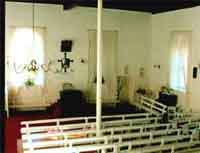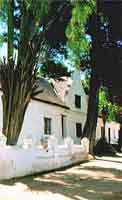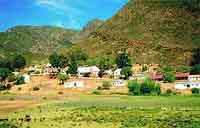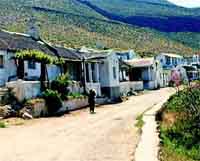West Coast
(Department of Cultural Affairs & Sport, Western Cape Government)
In October 1808, 326 slaves from over 30 farms in this region rebelled and marched on Cape Town to demand their freedom. They were led by Louis of Mauritius, Abraham of the Cape and an Irishman James Hooper, who promised them their freedom. They concentrated on the slaves of Pieter Louw of the Swartland and spread the uprising towards Koeberg and Tygervalley. In total 34 farms were plundered, the farmers bound and taken prisoner. When the slaves began to march to Cape Town, the Govenor, the Earl of Caledon, dispatched soldiers to the troubled area and all 326 slaves were taken prisoner. Five of the ringleaders were hanged publicly and their corpses were displayed in order to deter anyone of like mind. Large numbers of slaves worked in the labour-intensive wheat farms and mixed farming areas found in the Swartland and West Coast. Many mission stations in this area also testify to the missionary work done among the Khoekhoen and the slaves. The well-known ones are Wupperthal and Mamre, but there is also Papendorp, Troe-Troe Mission station in Van Rhynsdorp and Ebenhaezer. |
|
|||||
| Mamre (historic village and mission station on the R307) A mission station was established at Groene-kloof (Mamre) near Malmesbury in 1808 by the Moravian Missionary Society at a former military outpost on the farm Louwplaas as well as the farms De Groene Kloof and Cruywagenskraal. The missionaries Kohrhammer and Schmidt set out to work among the local Khoekhoen but the mission station also served as a haven for freed slaves. Today the old kerkwerf (churchyard) can still be seen as well as a mill, bakery, stables and a school. Tel: 021 576 1134 |
 Moravian church in Mamre |
|||||
|
Goedverwacht, Burgershoek near Piketberg (off the R399 between Piketberg and Velddrif) This settlement was the lawful property of a group of former slaves, who inherited the farm Burgerskloof from the owner, Hendrik Schalk Burger, upon emancipation in 1838. He left the farm to his slave Maniesa and her five children on condition that they take care of him until his death. His own children later contested the will, but the court upheld it and the farm remained Maniesa's property up to the death of her last child Hester in 1888. Her grave can be seen in the graveyard. Goedverwacht, a Moravian mission station, was established here later when the slave descendants sold the land to the Moravian missionaries for £750. Wupperthal (R364, 74 km from Clanwilliam) In 1828 two Rhenish missionaries, Johann Gottlieb Leipoldt and J von Wurm jointly bought the farm Rietmond on the Tratra River in the Cedarberg District. A mission station was established and named Wupperthal after the missionaries' home town in Germany. A large number of freed slaves settled here after emancipation. The Rhenish Missionary Society started several industries, namely, masonry, millinery, leather tanning, woodwork, thatching and shoe-making, an industry that is still practised. Today it is a Moravian mission station. |
||||||
|
||||||





